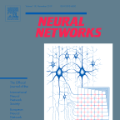Stress analysis of heterogeneous media, like composite materials, using Finite Element Analysis (FEA) has become commonplace in design and analysis. However, determining stress distributions in heterogeneous media using FEA can be computationally expensive in situations like optimization and multi-scaling. To address this, we utilize Deep Learning for developing a set of novel Difference-based Neural Network (DiNN) frameworks based on engineering and statistics knowledge to determine stress distribution in heterogeneous media, for the first time, with special focus on discontinuous domains that manifest high stress concentrations. The novelty of our approach is that instead of directly using several FEA model geometries and stresses as inputs for training a Neural Network, as typically done previously, we focus on highlighting the differences in stress distribution between different input samples for improving the accuracy of prediction in heterogeneous media. We evaluate the performance of DiNN frameworks by considering different types of geometric models that are commonly used in the analysis of composite materials, including volume fraction and spatial randomness. Results show that the DiNN structures significantly enhance the accuracy of stress prediction compared to existing structures, especially for composite models with random volume fraction when localized high stress concentrations are present.
翻译:对多种媒体的压力分析,如复合材料,使用精密元素分析(FEA),在设计和分析中已变得司空见惯。然而,在优化和多缩尺度等情况下,确定使用FEA的多种媒体的压力分布,在计算成本时可能非常昂贵。为了解决这个问题,我们利用深学习开发一套基于工程和统计知识的新颖的基于差异的神经网络(DINN)框架,以确定不同媒体的压力分布,首次特别侧重于显示高压力浓度的不连续领域。我们的方法的新颖之处是,不直接使用若干FEA模型的地理比例和压力作为培训神经网络的投入,而是像以往通常所做的那样,强调不同输入样本在压力分布上的差异,以提高不同媒体预测的准确性。我们通过考虑在分析复合材料时常用的不同类型的几何模型,包括体积分数和空间随机度,评估DINN框架的性。结果显示,DIN结构与现有结构相比,特别是当存在局部高压力浓度时,以随机体积的复合模型相比,大大提高了压力预测的准确性。





